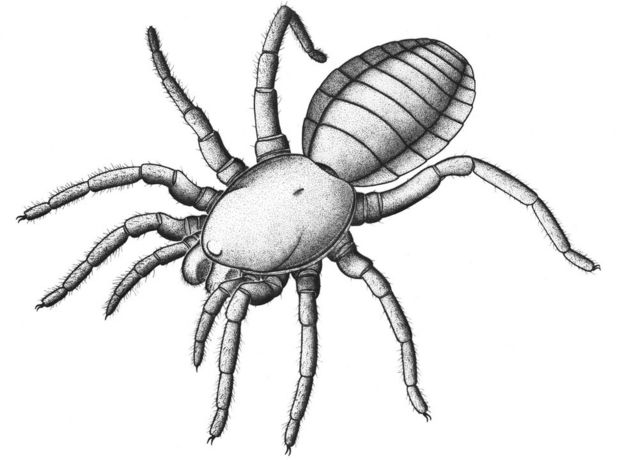Ancient fossil was 'nearly a spider'
By Jonathan WebbScience reporter, BBC News
30 March 2016
From the sectionScience & Environment
Jump media player
Media player help
Out of media player. Press enter to return or tab to continue.Media captionThe creature's mouthparts and limbs were very spider-like
Scientists say a 305 million-year-old fossil is the closest relative to "true spiders" ever discovered - but is not itself a spider.
Easily pre-dating the dinosaurs, the 1.5cm creature lived alongside the oldest known ancestors of modern spiders but its lineage is now extinct.
The specimen was dug up decades ago in France but never identified, because its front half was encased in rock.
Now, researchers have made a detailed reconstruction using CT scans.
Their findings are reported in the journal Proceedings of the Royal Society B.
"This fossil is the most closely related thing we have to a spider that isn't a spider," said first author Russell Garwood from the University of Manchester.
Legs and jaws
Now christened Idmonarachne brasieri, the arachnid was among "a box full of fossils" that Dr Garwood's co-author Paul Selden, from the University of Kansas in the US, had borrowed from the Museum National d'Histoire Naturelle in Paris in the 1980s.
It originally came from a rich region of fossil-bearing deposits near Montceau les-Mines, in eastern France.
 Image copyrightGarwood et al 2016/MNHN, ParisImage captionThe front half of the fossil, buried in rock, could only be revealed by CT scans
Image copyrightGarwood et al 2016/MNHN, ParisImage captionThe front half of the fossil, buried in rock, could only be revealed by CT scans"By CT scanning it, you can actually extract the full front half of the animal from the rock, to try and better understand its anatomy," Dr Garwood told BBC News.
First of all, as well as the animal's eight spidery limbs, he and his colleagues spotted some imposing jaws. These confirmed that it was a new species and not one of the more distant cousins of spiders known from the same period.
It also lacked the tail-like appendage of the older, similarly long-extinct arachnid family that included Attercopus, living some 80 million years earlier. Those earlier critters could produce silk, probably to line their burrows or make a trail to follow home, but did not have the spinnerets that allow spiders to weave webs.
As such, Dr Garwood explained, the new arrival I. brasieri fills a gap - having spider-like legs and jaws but still lacking spinnerets.
"Our creature probably split off the spider line after [Attercopus], but before true spiders appeared," he said.
 Image copyrightGarwood et al 2016Image captionThe creature dates to the late Carboniferous period and belongs to a now-extinct lineage
Image copyrightGarwood et al 2016Image captionThe creature dates to the late Carboniferous period and belongs to a now-extinct lineage"The earliest known spider is actually from the same fossil deposit - and it definitely has spinnerets. So what we're actually looking at is an extinct lineage that split off the spider line some time before 305 million years ago, and those two have evolved in parallel."
To confirm that the extinct critter definitely lacked spinnerets, the team switched from a regular laboratory CT scanner to using the high-powered X-rays of theDiamond synchrotron in Oxfordshire.
"We had to consider the fact they could have fallen out, and just left a hole in the abdomen," Dr Garwood said. "You need a quite high-resolution scan to be able to spot that distortion."
With all the evidence in place, the team was able to name their discovery. They chose to commemorate a colleague: Martin Brasier, an Oxford palaeobiologist who died recently in a car accident.
"He was a very supportive academic," said Dr Garwood.
Follow Jonathan on Twitter
Sem comentários:
Enviar um comentário